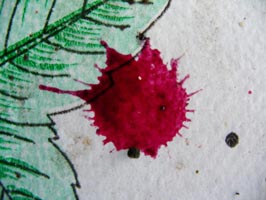
Former HARP artist Naomi Uman returns to Hallwalls from Eastern Europe. Hoping to experience what it is like to be an immigrant, the filmmaker moved to the Ukraine shortly after her 2005 residency—a reverse journey taken by her great-grandparents in 1906. She will show four 16mm films from the Ukrainian Time Machine series that combine personal, experimental and non-fiction approaches to capturing life in the town of Uman, where people live as it were 100 years ago.
Kalendar
11 minutes, color, silent, sixteen millimeter film, 2008
This ten minute, silent, color film which depicts the meaning of the months of the year in the Ukrainian language. Each month is presented and followed with a title card which gives the name of the month in Ukrainian Cyrillic, the meaning of that name in italics and the name of the month in English. This film speaks to the concept of language acquisition as you are presented the word for the month, but you are not given a transliteration. If you are unable to read the letters, you can not know how the word will sound. This film, in its silence, represents the door that can be opened when a language is learned, but that remains closed until that time.

Unnamed Film
55 minutes, color, 16 millimeter film, 2008
This project is the result of the filmmaker's attempt to investigate issues of immigration by becoming an immigrant herself. Naomi Uman returned to the land her great grandparents left in 1906. She moved to Ukraine, without speaking the language or knowing anyone. She moved near the city of Uman, to a small rural village where people live as they did 100 years ago.
On This Day
5 minutes, color, sound, 16 millimeter film, 2008
This film tells the true story of one day in the life of the filmmaker.
ABOUT THE ARTIST:
Naomi Uman is a visual artist. She works in a variety of media and formats. Her work addresses themes of work, geography, immigration, language and love. She has recently completed a series of films, all shot in a rural Ukrainian village, near the city of Uman. She has worked in the United States, Mexico and is now living in Ukraine where, accompanied by her small dog, continues making films, planting vegetables and flowers and making paintings of animals.
5 minutes, color, sound, 16 millimeter film, 2008
This film tells the true story of one day in the life of the filmmaker.
ABOUT THE ARTIST:
Naomi Uman is a visual artist. She works in a variety of media and formats. Her work addresses themes of work, geography, immigration, language and love. She has recently completed a series of films, all shot in a rural Ukrainian village, near the city of Uman. She has worked in the United States, Mexico and is now living in Ukraine where, accompanied by her small dog, continues making films, planting vegetables and flowers and making paintings of animals.



